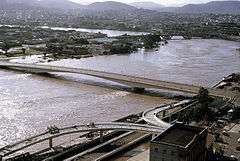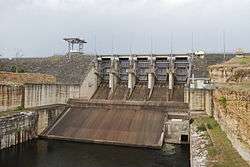1974 Brisbane flood
In January 1974 a flood occurred in Brisbane, Queensland, Australia after three weeks of continual rain. The Brisbane River, which runs through the heart of the city, broke its banks and flooded the surrounding areas.[2] The cyclone that produced the flood also flooded surrounding cities: Ipswich, Beenleigh, and the Gold Coast.[2][3]
 Victoria Bridge during flood | |
| Date | 24 January - 31 January 1974 |
|---|---|
| Location | Ipswich, Brisbane |
| Deaths | 16[1] |
| Property damage | A$980 million[1] |


In total, there were 16 fatalities, 300 people injured, 8000 homes destroyed and an estimated A$980 million in damages.[1]
Flood waters
| Precipitation | Storm | Location | Ref. | ||
|---|---|---|---|---|---|
| Rank | mm | in | |||
| 1 | 1,947 | 76.65 | Peter 1979 | Mount Bellenden Ker | [4] |
| 2 | 1,870 | 73.62 | Rona–Frank 1999 | Mount Bellenden Ker | [4] |
| 3 | 1,318 | 51.89 | Wanda 1974 | Mount Glorious | [5] |
| 4 | 1,256.8 | 49.48 | Fletcher 2014 | Kowanyama | [6][7] |
| 5 | 1,082 | 42.60 | Aivu 1989 | Dalrymple Heights | [8] |
| 6 | 1,065 | 41.93 | May 1998 | Burketown | [9] |
| 7 | 1,000 | 39.37 | Justin 1997 | Willis Island | [10] |
| 7 | 1,000 | 39.37 | Ellie 2009 | [11] | |
| 7 | 1,000 | 39.37 | Oswald 2013 | Tully | [12] |
| 8 | 986 | 38.82 | Debbie 2017 | Clarke Range | [13] |
It had been an exceptionally wet spring, and by the end of October most of southern Queensland's river systems were nearing capacity. Cyclone Wanda pushed the systems to the limit, and drew the monsoonal trough southward, providing the additional rainfall to the Brisbane River, Bremer River and Stanley River catchments to produce widespread and severe flooding. In the early morning of 25 January heavy rain began to fall on Brisbane. During a 36-hour period 642 mm of rain fell on the city.[14] These torrential rains were caused by Wanda, a relatively weak tropical cyclone which did not even rate as a category 1 cyclone.[15]
Continual, heavy rain had fallen for three weeks, leading up to the flood, which occurred on Sunday, 27 January 1974, during the Australia Day weekend. The floods peaked at 6.6 metres (22 ft) according to the Port Office gauge at high tide at 2:15 am on 29 January.[16]:35 The peak flooding in the location of the city gauge was approximately 5.5 metres (18 ft).[17]
Damage
Large areas were inundated, with at least 6,700 homes flooded. Around 13,000 buildings were affected by flooding in some way.[18] Buildings in the Brisbane central business district were particularly hard hit.[14]
The 67,320 tonne Robert Miller broke its moorings at Kangaroo Point and became adrift in the river. Because the ship was 237 metres long and the river was about 255 metres wide, it was feared that the ship could form a dam across the river. This would have caused the river to rise by a further 3 metres, leading even greater flooding in the suburbs.[19] Two tugboats were needed to control the 15 m high and 239 m long oil tanker.[16]:38 The Robert Miller was the largest ship ever built in Australia at the time.[20]
A gravel barge became caught under the Centenary Bridge where it damaged the pylons, causing fear that the bridge would be swept away. The barge was sunk to reduce the risk.[16]:38[19]
The most flood affected suburb of Brisbane was Rocklea.[21]
Close to Ipswich, 1,800 premises were affected by flooding.[22]
The Nerang River flooded, cutting the Gold Coast off from Brisbane. About 2000 people were evacuated from homes along the river and the canals; most of these homes suffered flood damage.[19]
The total damage in Brisbane and the surrounding areas was initially estimated at A$200 million,[16]:8 but the final value was over A$980 million (1974 values), with $328 million made in insurance claims.[1] While not as high as the floods in the 1800s this flood is considered to have been worse due to Brisbane's rapidly increasing population at the time.
Many houses were also damaged by land subsidence and land slippage associated with the flooding and high rainfall.[16]:8
Fatalities
Sixteen people lost their lives, including twelve people who were drowned in Brisbane and Ipswich.[23]
The first flood related deaths were at 11:20pm on 24 January. Raymond Roy Davidson (29 years, from Wacol) and Hazel Dulcie Afflick (40 years) were killed in a head-on collision at Wacol, both drivers being blinded by gale-force winds and heavy rain.[24]
An army amphibious LARC vehicle was carrying out excavation work at Bellbowrie when the vehicle hit submerged power lines which were still live. Two men, Corporal Neville Hourigan and Captain Ian Kerr of the Australian Army Reserve (then called the Citizens Military Force) were thrown from the vehicle. Bill Lickiss jumped into the water to save them.[24] Hourigan died at the scene and Kerr's body was found after the flood had subsided. Lickiss was awarded the Queen's Gallantry Medal.[2]
A young child, Shane David Patterson (of Yeronga) was swept from his father's arms on a causeway over Oxley Creek in Inala and drowned.[2]
In addition to those that drowned, Robert Adams (aged 56 years) died of a heart attack during an evacuation of a caravan park at Newmarket. Aidan Sutton, a civilian working with the Queensland Police, aged 50 years, returned home to St Lucia for his reading glasses and was swept away in the flood waters, his body found in a tree.[24]
Aftermath

After the flood, a series of flood mitigation measures were implemented in Southeast Queensland, including the Wivenhoe Dam along the Brisbane River.[25]
The flood was a defining event for a generation of Brisbane residents with 8,500 homes flooded in Brisbane and Ipswich, 6,000 of these could not be recovered.[26]
The flood had massive economic implications due to loss of export infrastructure.
In 2009 as part of the Q150 celebrations, the 1974 Brisbane flood was announced as one of the Q150 Icons of Queensland for its role as a "Defining Moment".[27]
References
- "Australia's Worst Floods". Queensland Government State Disaster Management Group. 17 December 2005. Archived from the original on 12 December 2009. Retrieved 26 January 2018.
- "Brisbane '74: Long weekend from hell". Courier-Mail. 24 January 2014.
- "Queensland Flood Summary 1970 - 1979". Retrieved 14 September 2019.
- "Climate Education: Flood". Australian Bureau of Meteorology. Archived from the original on 17 March 2009. Retrieved 18 January 2011.
- Bureau of Meteorology. Tropical Cyclones in Queensland. Retrieved on 17 July 2015.
- "Tropical Cyclone Fletcher Impacts". Bureau of Meteorology. Government of Australia. 2014. Retrieved 5 March 2014.
- "Kowanyama, Queensland February 2014 Daily Weather Observations" (PDF). Bureau of Meteorology. Government of Australia. 2014. Archived from the original (PDF) on 6 March 2014. Retrieved 6 March 2014.
- "Report on Severe Tropical Cyclone Aivu: Rainfall" (PDF). Bureau of Meteorology. Government of Australia. 6 June 1990. p. 17–18. Retrieved 13 March 2014.
- "Tropical Cyclone May". Australian Bureau of Meteorology. 2013. Retrieved 29 January 2013.
- Queensland Tropical Cyclone Warning Centre (2014). "Tropical Cyclone Justin" (PDF). Australian Bureau of Meteorology. Retrieved 11 March 2014.
- "Tropical Cyclone Ellie". Australian Bureau of Meteorology. 2009. Retrieved 27 January 2013.
- Williams, Brian; Michael, Peter (24 January 2013). "Ex-cyclone Oswald heads south with heavy rain tipped for long weekend". The Courier Mail. Australian Associated Press. Archived from the original on 24 January 2013. Retrieved 24 January 2013.
- http://www.bom.gov.au/announcements/sevwx/qld/qldtc20170325.shtml
- McBride, Frank; et al. (2009). Brisbane 150 Stories. Brisbane City Council Publication. pp. 256–257. ISBN 978-1-876091-60-6.
- "Season 1973-1974 Tropical Cyclone WANDA Track Map". Retrieved 25 September 2013.
- "Brisbane floods January 1974: Report by Director of Meteorology" (PDF). Canberra: Bureau of Meteorology, Commonwealth of Australia. 1974. Retrieved 25 September 2013.
- "Brisbane River at City Gauge: Highest Annual Flood Peaks". Bureau of Meteorology, Commonwealth of Australia. Retrieved 12 January 2011.
- Gregory, Helen; Dianne Mclay (2010). Building Brisbane's History: Structure, Sculptures, Stories and Secrets. Warriewood, New South Wales: Woodslane Press. p. 148. ISBN 9781921606199.
- Freudenberg, John (20 January 2014). "Brisbane '74: Long weekend from hell". The Courier-Mail. Retrieved 23 May 2018.
- Geoff Strong (17 January 2011). "The boat that almost became a ruinous dam". Brisbane Times. Fairfax Digital. Retrieved 20 February 2011.
- "Rocklea". Queensland Places. Centre for the Government of Queensland. Retrieved 22 September 2012.
- Gary Kitchener (11 January 2011). "Queensland rebuilding 'huge task'". BBC News. Archived from the original on 17 February 2011. Retrieved 20 February 2011.
- "Historical Impacts Along The East Coast". Bureau of Meteorology. Retrieved 26 January 2018.
- Brown, Malcolm (2010). Australia's Worst Disasters. Hachette Australia. p. 167. ISBN 9780733626111.
- "Wivenhoe and Somerset Dams" (PDF). SEQ Water Grid. The Queensland Cabinet and Ministerial Directory. Retrieved 13 January 2011.
- . 4WD Australia. Retrieved on 28 April 2015.
- Bligh, Anna (10 June 2009). "PREMIER UNVEILS QUEENSLAND'S 150 ICONS". Queensland Government. Archived from the original on 24 May 2017. Retrieved 24 May 2017.
External links
| Wikimedia Commons has media related to 1974 Brisbane flood. |